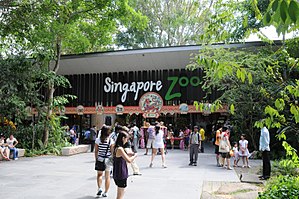Singapore Zoo
 |
|
| Date opened | 27 June 1973 |
|---|---|
| Location | Singapore |
| Coordinates | 1°24′14″N 103°47′39″E / 1.403782°N 103.79414°ECoordinates: 1°24′14″N 103°47′39″E / 1.403782°N 103.79414°E |
| Land area | 28 ha (69 acres) |
| Number of animals | 2,530 |
| Number of species | 315 |
| Annual visitors | 1.7 million |
| Website | Singapore Zoo |
The Singapore Zoo, formerly known as the Singapore Zoological Gardens and commonly known locally as the Mandai Zoo, occupies 28 hectares (69 acres) on the margins of Upper Seletar Reservoir within Singapore's heavily forested central catchment area. The zoo was built at a cost of $9 million granted by the government of Singapore and opened on 27 June 1973. It is operated by Wildlife Reserves Singapore, who also manage the neighbouring Night Safari, River Safari and the Jurong BirdPark. There are about 315 species of animal in the zoo, of which some 16 percent are considered to be threatened species. The zoo attracts 1.7 million visitors each year.
From the beginning, Singapore Zoo followed the modern trend of displaying animals in naturalistic, 'open' exhibits with hidden barriers, moats, and glass between the animals and visitors. It houses the largest captive colony of orangutans in the world.
Prior to the establishment of Singapore Zoo, there were other short-lived zoos in Singapore's history, including the first recorded zoo founded in the early 1870s at the present-day Singapore Botanic Gardens, a zoo opened in the 1920s in Ponggol (present-day Punggol) by animal trader William Lawrence Soma Basapa and two zoos run by two brothers by the surname of Chan during the 1960s.
The conception of the Singapore Zoo dates from 1969. At the time, the Public Utilities Board (PUB) decided to use some of its land holdings around reservoirs for parks and open recreational facilities. The executive chairman of the PUB, Dr Ong Swee Law, set aside 88 ha (220 acres) of land for the construction of a zoological garden.
...
Wikipedia
